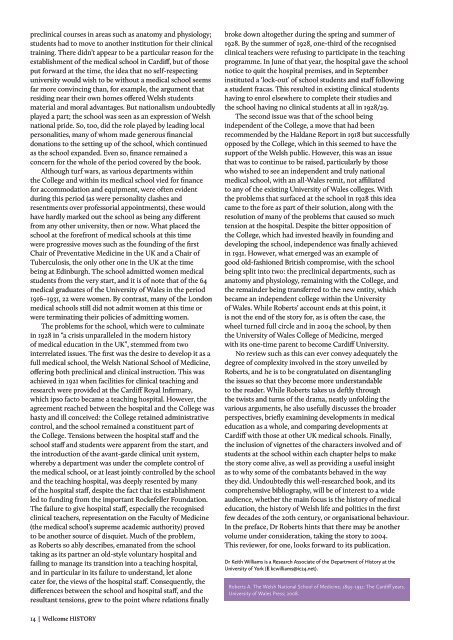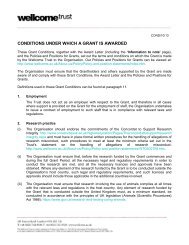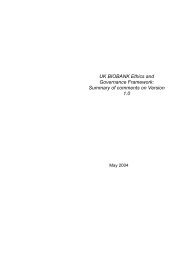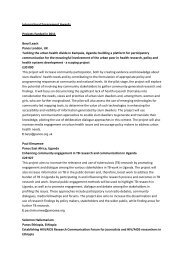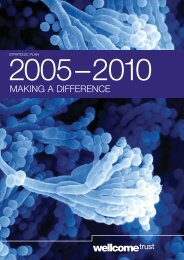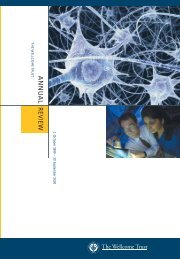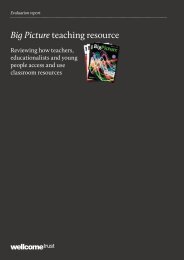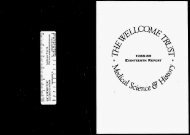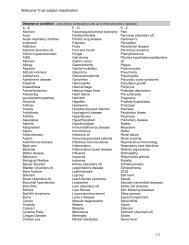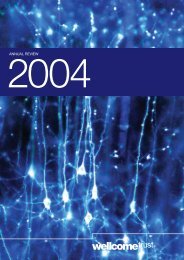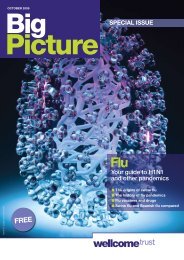(1839–1910) Medical history in Japan - Wellcome Trust
(1839–1910) Medical history in Japan - Wellcome Trust
(1839–1910) Medical history in Japan - Wellcome Trust
Create successful ePaper yourself
Turn your PDF publications into a flip-book with our unique Google optimized e-Paper software.
precl<strong>in</strong>ical courses <strong>in</strong> areas such as anatomy and physiology;students had to move to another <strong>in</strong>stitution for their cl<strong>in</strong>icaltra<strong>in</strong><strong>in</strong>g. There didn’t appear to be a particular reason for theestablishment of the medical school <strong>in</strong> Cardiff, but of thoseput forward at the time, the idea that no self-respect<strong>in</strong>guniversity would wish to be without a medical school seemsfar more conv<strong>in</strong>c<strong>in</strong>g than, for example, the argument thatresid<strong>in</strong>g near their own homes offered Welsh studentsmaterial and moral advantages. But nationalism undoubtedlyplayed a part; the school was seen as an expression of Welshnational pride. So, too, did the role played by lead<strong>in</strong>g localpersonalities, many of whom made generous f<strong>in</strong>ancialdonations to the sett<strong>in</strong>g up of the school, which cont<strong>in</strong>uedas the school expanded. Even so, f<strong>in</strong>ance rema<strong>in</strong>ed aconcern for the whole of the period covered by the book.Although turf wars, as various departments with<strong>in</strong>the College and with<strong>in</strong> its medical school vied for f<strong>in</strong>ancefor accommodation and equipment, were often evidentdur<strong>in</strong>g this period (as were personality clashes andresentments over professorial appo<strong>in</strong>tments), these wouldhave hardly marked out the school as be<strong>in</strong>g any differentfrom any other university, then or now. What placed theschool at the forefront of medical schools at this timewere progressive moves such as the found<strong>in</strong>g of the firstChair of Preventative Medic<strong>in</strong>e <strong>in</strong> the UK and a Chair ofTuberculosis, the only other one <strong>in</strong> the UK at the timebe<strong>in</strong>g at Ed<strong>in</strong>burgh. The school admitted women medicalstudents from the very start, and it is of note that of the 64medical graduates of the University of Wales <strong>in</strong> the period1916–1931, 22 were women. By contrast, many of the Londonmedical schools still did not admit women at this time orwere term<strong>in</strong>at<strong>in</strong>g their policies of admitt<strong>in</strong>g women.The problems for the school, which were to culm<strong>in</strong>ate<strong>in</strong> 1928 <strong>in</strong> “a crisis unparalleled <strong>in</strong> the modern <strong>history</strong>of medical education <strong>in</strong> the UK”, stemmed from two<strong>in</strong>terrelated issues. The first was the desire to develop it as afull medical school, the Welsh National School of Medic<strong>in</strong>e,offer<strong>in</strong>g both precl<strong>in</strong>ical and cl<strong>in</strong>ical <strong>in</strong>struction. This wasachieved <strong>in</strong> 1921 when facilities for cl<strong>in</strong>ical teach<strong>in</strong>g andresearch were provided at the Cardiff Royal Infirmary,which ipso facto became a teach<strong>in</strong>g hospital. However, theagreement reached between the hospital and the College washasty and ill conceived: the College reta<strong>in</strong>ed adm<strong>in</strong>istrativecontrol, and the school rema<strong>in</strong>ed a constituent part ofthe College. Tensions between the hospital staff and theschool staff and students were apparent from the start, andthe <strong>in</strong>troduction of the avant-garde cl<strong>in</strong>ical unit system,whereby a department was under the complete control ofthe medical school, or at least jo<strong>in</strong>tly controlled by the schooland the teach<strong>in</strong>g hospital, was deeply resented by manyof the hospital staff, despite the fact that its establishmentled to fund<strong>in</strong>g from the important Rockefeller Foundation.The failure to give hospital staff, especially the recognisedcl<strong>in</strong>ical teachers, representation on the Faculty of Medic<strong>in</strong>e(the medical school’s supreme academic authority) provedto be another source of disquiet. Much of the problem,as Roberts so ably describes, emanated from the schooltak<strong>in</strong>g as its partner an old-style voluntary hospital andfail<strong>in</strong>g to manage its transition <strong>in</strong>to a teach<strong>in</strong>g hospital,and <strong>in</strong> particular <strong>in</strong> its failure to understand, let alonecater for, the views of the hospital staff. Consequently, thedifferences between the school and hospital staff, and theresultant tensions, grew to the po<strong>in</strong>t where relations f<strong>in</strong>allybroke down altogether dur<strong>in</strong>g the spr<strong>in</strong>g and summer of1928. By the summer of 1928, one-third of the recognisedcl<strong>in</strong>ical teachers were refus<strong>in</strong>g to participate <strong>in</strong> the teach<strong>in</strong>gprogramme. In June of that year, the hospital gave the schoolnotice to quit the hospital premises, and <strong>in</strong> September<strong>in</strong>stituted a ‘lock-out’ of school students and staff follow<strong>in</strong>ga student fracas. This resulted <strong>in</strong> exist<strong>in</strong>g cl<strong>in</strong>ical studentshav<strong>in</strong>g to enrol elsewhere to complete their studies andthe school hav<strong>in</strong>g no cl<strong>in</strong>ical students at all <strong>in</strong> 1928/29.The second issue was that of the school be<strong>in</strong>g<strong>in</strong>dependent of the College, a move that had beenrecommended by the Haldane Report <strong>in</strong> 1918 but successfullyopposed by the College, which <strong>in</strong> this seemed to have thesupport of the Welsh public. However, this was an issuethat was to cont<strong>in</strong>ue to be raised, particularly by thosewho wished to see an <strong>in</strong>dependent and truly nationalmedical school, with an all-Wales remit, not affiliatedto any of the exist<strong>in</strong>g University of Wales colleges. Withthe problems that surfaced at the school <strong>in</strong> 1928 this ideacame to the fore as part of their solution, along with theresolution of many of the problems that caused so muchtension at the hospital. Despite the bitter opposition ofthe College, which had <strong>in</strong>vested heavily <strong>in</strong> found<strong>in</strong>g anddevelop<strong>in</strong>g the school, <strong>in</strong>dependence was f<strong>in</strong>ally achieved<strong>in</strong> 1931. However, what emerged was an example ofgood old-fashioned British compromise, with the schoolbe<strong>in</strong>g split <strong>in</strong>to two: the precl<strong>in</strong>ical departments, such asanatomy and physiology, rema<strong>in</strong><strong>in</strong>g with the College, andthe rema<strong>in</strong>der be<strong>in</strong>g transferred to the new entity, whichbecame an <strong>in</strong>dependent college with<strong>in</strong> the Universityof Wales. While Roberts’ account ends at this po<strong>in</strong>t, itis not the end of the story for, as is often the case, thewheel turned full circle and <strong>in</strong> 2004 the school, by thenthe University of Wales College of Medic<strong>in</strong>e, mergedwith its one-time parent to become Cardiff University.No review such as this can ever convey adequately thedegree of complexity <strong>in</strong>volved <strong>in</strong> the story unveiled byRoberts, and he is to be congratulated on disentangl<strong>in</strong>gthe issues so that they become more understandableto the reader. While Roberts takes us deftly throughthe twists and turns of the drama, neatly unfold<strong>in</strong>g thevarious arguments, he also usefully discusses the broaderperspectives, briefly exam<strong>in</strong><strong>in</strong>g developments <strong>in</strong> medicaleducation as a whole, and compar<strong>in</strong>g developments atCardiff with those at other UK medical schools. F<strong>in</strong>ally,the <strong>in</strong>clusion of vignettes of the characters <strong>in</strong>volved and ofstudents at the school with<strong>in</strong> each chapter helps to makethe story come alive, as well as provid<strong>in</strong>g a useful <strong>in</strong>sightas to why some of the combatants behaved <strong>in</strong> the waythey did. Undoubtedly this well-researched book, and itscomprehensive bibliography, will be of <strong>in</strong>terest to a wideaudience, whether the ma<strong>in</strong> focus is the <strong>history</strong> of medicaleducation, the <strong>history</strong> of Welsh life and politics <strong>in</strong> the firstfew decades of the 20th century, or organisational behaviour.In the preface, Dr Roberts h<strong>in</strong>ts that there may be anothervolume under consideration, tak<strong>in</strong>g the story to 2004.This reviewer, for one, looks forward to its publication.Dr Keith Williams is a Research Associate of the Department of History at theUniversity of York (E kcwilliams@ic24.net).Roberts A. The Welsh National School of Medic<strong>in</strong>e, 1893–1931: The Cardiff years.University of Wales Press; 2008.14 | <strong>Wellcome</strong> HISTORY


